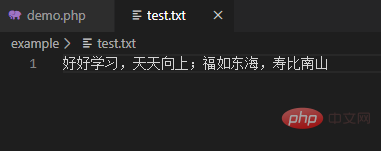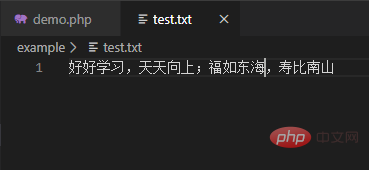Teach you how to write files in PHP in three minutes?
In the previous article, I brought you "How to read files in PHP? (Sharing Summary) ", which introduces in detail how we should read files. This article will continue to show you how we should create and modify files. I hope it will be helpful to everyone!

Reading files must be no longer difficult for everyone, so let’s take a look at how we should modify the file or create the file and modify it.
file_put_contents writes to a file
First, let’s learn a writing method, file_put_contents(), Its syntax is as follows:
int file_put_contents ( string $文件路径, string $写入数据])
It can write a string to the specified file. If the file does not exist, file_put_contents will create a file and return the length of the written bytes. At the same time, you need to know that if there is content in the specified file, it will overwrite the previous content.
The example is as follows:
<?php
$a = "好好学习,天天向上;福如东海,寿比南山";
$b = file_put_contents('test.txt', $a);
if($b){
echo '写入成功,我们读取看看结果试试:';
echo file_get_contents('test.txt');
}else{
echo '写入失败或者没有权限,注意检查';
}
?>Output result:

Test does not originally exist in my directory. txt, after passing the function, test.txt appeared in my directory, and the content is as follows:

We can see from the above example that it is not difficult to write a file Yes, according to the specified function format, the specified file can be written.
<span style="max-width:90%"><strong>fwrite</strong></span> Write with fopen Input operation
#fwrite() function is used to write a string to the file and returns the number of characters written successfully, otherwise it returns FALSE.
First of all, let’s talk about the grammatical structure of fwrite as follows:
int fwrite ( resource $文件资源变量, string $写入的字符串 [, int 长度])
Next we use fwrite plus w in fopen, write mode to write files. The characteristic, as we mentioned in the previous article, is to open in writing mode, point the file pointer to the file header and cut the file size to zero. If the file does not exist then attempts to create it.
<?php $a = 'test.txt'; $b= fopen($a, "w"); $c = fwrite($b, '好好学习,天天向上;福如东海,寿比南山'); fclose($b); print $c .'字节被写入了\n'; ?>
Output result:

test.txt in the directory The content of the file is as follows:

From the above example we can get the following summary:
The file will be opened and rewritten regardless of whether there is a new one
The original file content will be overwritten
If the file does not exist, it will be created
Next, let’s compare the differences between several modes:
r---can only be read and cannot be written using fwriter---Can operate read and writew---Only can write functionw---Readable and writable
For example:
Still the above example, put the Replace w with r, the example is as follows:
<?php $a = 'test.txt'; $b= fopen($a, "r"); $c = fwrite($b, '好好学习,天天向上;'); fclose($b); print $c .'字节被写入了\n'; ?>
Output result:

Through the example we found that writing in r mode is unsuccessful.
The difference between a mode and w mode
Let’s try the above code and replace r with a. , the example is as follows:
<?php $a = 'test.txt'; $b= fopen($a, "a"); $c = fwrite($b, '好好学习,天天向上;'); fclose($b); print $c .'字节被写入了\n'; ?>
Output result:

## The text content of test.txt is as follows:

Through the above example, we found that in a mode, every time it is refreshed, it will be written once more. Each write will append content to the end of the file.
Recommended learning: "PHP Video Tutorial"
The above is the detailed content of Teach you how to write files in PHP in three minutes?. For more information, please follow other related articles on the PHP Chinese website!

Hot AI Tools

Undresser.AI Undress
AI-powered app for creating realistic nude photos

AI Clothes Remover
Online AI tool for removing clothes from photos.

Undress AI Tool
Undress images for free

Clothoff.io
AI clothes remover

AI Hentai Generator
Generate AI Hentai for free.

Hot Article

Hot Tools

Notepad++7.3.1
Easy-to-use and free code editor

SublimeText3 Chinese version
Chinese version, very easy to use

Zend Studio 13.0.1
Powerful PHP integrated development environment

Dreamweaver CS6
Visual web development tools

SublimeText3 Mac version
God-level code editing software (SublimeText3)

Hot Topics
 CakePHP Project Configuration
Sep 10, 2024 pm 05:25 PM
CakePHP Project Configuration
Sep 10, 2024 pm 05:25 PM
In this chapter, we will understand the Environment Variables, General Configuration, Database Configuration and Email Configuration in CakePHP.
 PHP 8.4 Installation and Upgrade guide for Ubuntu and Debian
Dec 24, 2024 pm 04:42 PM
PHP 8.4 Installation and Upgrade guide for Ubuntu and Debian
Dec 24, 2024 pm 04:42 PM
PHP 8.4 brings several new features, security improvements, and performance improvements with healthy amounts of feature deprecations and removals. This guide explains how to install PHP 8.4 or upgrade to PHP 8.4 on Ubuntu, Debian, or their derivati
 CakePHP Date and Time
Sep 10, 2024 pm 05:27 PM
CakePHP Date and Time
Sep 10, 2024 pm 05:27 PM
To work with date and time in cakephp4, we are going to make use of the available FrozenTime class.
 CakePHP File upload
Sep 10, 2024 pm 05:27 PM
CakePHP File upload
Sep 10, 2024 pm 05:27 PM
To work on file upload we are going to use the form helper. Here, is an example for file upload.
 CakePHP Routing
Sep 10, 2024 pm 05:25 PM
CakePHP Routing
Sep 10, 2024 pm 05:25 PM
In this chapter, we are going to learn the following topics related to routing ?
 Discuss CakePHP
Sep 10, 2024 pm 05:28 PM
Discuss CakePHP
Sep 10, 2024 pm 05:28 PM
CakePHP is an open-source framework for PHP. It is intended to make developing, deploying and maintaining applications much easier. CakePHP is based on a MVC-like architecture that is both powerful and easy to grasp. Models, Views, and Controllers gu
 CakePHP Creating Validators
Sep 10, 2024 pm 05:26 PM
CakePHP Creating Validators
Sep 10, 2024 pm 05:26 PM
Validator can be created by adding the following two lines in the controller.
 How To Set Up Visual Studio Code (VS Code) for PHP Development
Dec 20, 2024 am 11:31 AM
How To Set Up Visual Studio Code (VS Code) for PHP Development
Dec 20, 2024 am 11:31 AM
Visual Studio Code, also known as VS Code, is a free source code editor — or integrated development environment (IDE) — available for all major operating systems. With a large collection of extensions for many programming languages, VS Code can be c






